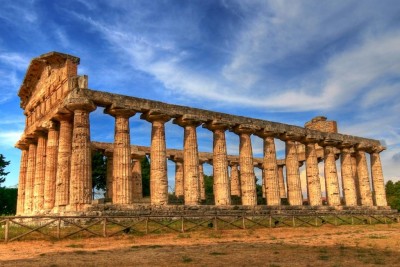Exploring the Ancient Greek City of Paestum
An article by Anne Roth published on March 11th 2001 by the Post-Standard of Syracuse (NY)


Only about 20 percent of Paestum has been excavated since the mid-18th century. The ruins include some of the finest and best-preserved Doric temples in existence. Doric defines the earliest classical Greek architecture, typified by fluted columns. The land was flat, the sea on one side, mountains on the other.As we drove, ruins of an ancient temple came into view, then another and yet another. We had arrived in Paestum, a town in the Campania region of southern Italy. We had been promised antiquity; we were not disappointed. Paestum dates from 600 B.C. The temples were built by Greek colonists who had settled in Calabria, further south in Italy. The first, Apollo's Temple, dates from 550 B.C.; Athena Temple from 500 B.C.; Poseidon Temple, 450 B.C. Paestum has the only remaining remnants of Greek colonies on the mainland of Italy.Unlike Pompeii, the well-known excavation site to the northeast of Sorrento in the Bay of Naples, Paestum is not packed with tourists. It was rediscovered in 1746 when a road was built by the Bourbon king to connect Naples with the Calabrian region. The first excavation - the three Doric temples, six columns on each short side; 13 columns on each long side - was in 1798.But there is more to Paestum than the Greek influence.Romans took up residence in 273 B.C. Excavations reveal their presence: roads, a Roman temple with Corinthian columns, a forum, a large house, its mosaic floor still visible. At one time, ancient Paestum had 30,000 inhabitants. After the fall of the Roman Empire in 476 A.D., Christian priests used the Temple of Poseidon as a basilica.Painted tombs were discovered in the beginning of the 19th century; 150 years later 300 painted slabs were recovered. After World War II, soldiers discovered more tombs while building an airport.In 1954, eight bronze vases containing honey, still preserved by wax, were discovered in an underground shrine. In 1999, while cutting grass, a small terra pitcher was found holding 646 Roman coins which date from the second century B.C.Excavation and preservation work is ongoing. When we visited, the youngest of the three temples was surrounded by scaffolding to shore it up. We were told it would be removed in two weeks."Much of the town is still buried," our guide, Lucio, told us. "There is still a lot to uncover under the marshes near the sea that has not been touched."We walked the ancient town, its streets laid out in a discernible grid. We learned that the large blocks of limestone we passed by were placed there using inclined platforms. We peered down at an underground shrine surrounded by partial walls of limestone. It was intriguing to spot a Doric column here, a fountain there.There is a swimming pool with six water slides in a private Roman house. What was the purpose of the slides, we wondered? So that bathers could acclimatize in warm water before plunging into the pool's cold water, we were told.In ancient times, the town had a gymnasium: a complex in two sections, one open for sports, the other holding a swimming pool , about 154 feet long by 131 feet wide. An inclined aqueduct furnished the water.The Greek temples were the most awe-inspiring. The youngest of the three, Poseidon, resembled the Parthenon in Greece. Its columns, 2,500 years after being built, still hold the weight of its roof.Through the work of Mario Napoli in the 1960s, the Paestum Museum now houses one of the largest existing collections of Archaic Greek sculpture. The museum's signage is excellent; its layout easy to follow as it progresses through Greek, then Roman and later Christian periods.I was particularly intrigued by the "Tomb of the Diver" from 480 B.C. Its chest and lid are decorated. The image of the diver on the lid perhaps represents the passage into the beyond. Another tomb's slab has a fresco-like painting of a chariot race. Historians tell us they represent the final moment of the competition, designating the winner and the loser. Others have boxing scenes. Violence is indicated by blood running down the boxers' faces.Elaborate bronze, silver and gold jewelry - necklaces, bracelets, rings, earrings - excavated from tombs is displayed in the museum. There are vases, ladles, cups, and andirons and cooking spits from fireplaces. On the third floor is the newest important find: the 647 coins and terra cotta pitcher."Treasure is waiting for us," Lucio said as we headed there.The concept sums up the entire visit.
This article, by Anne Roth, was published on March 11th 2001 in the Post-Standard of Syracuse (NY)

